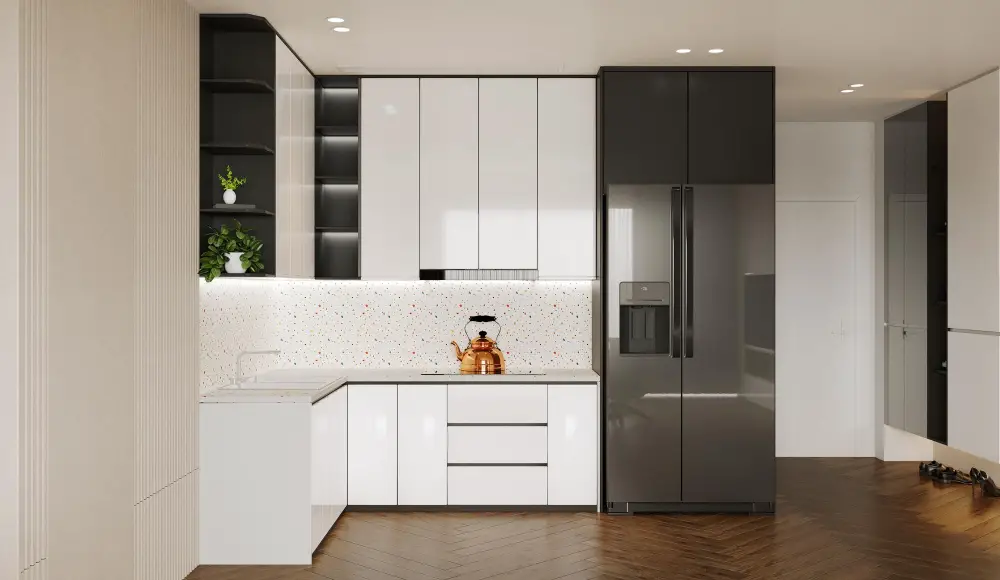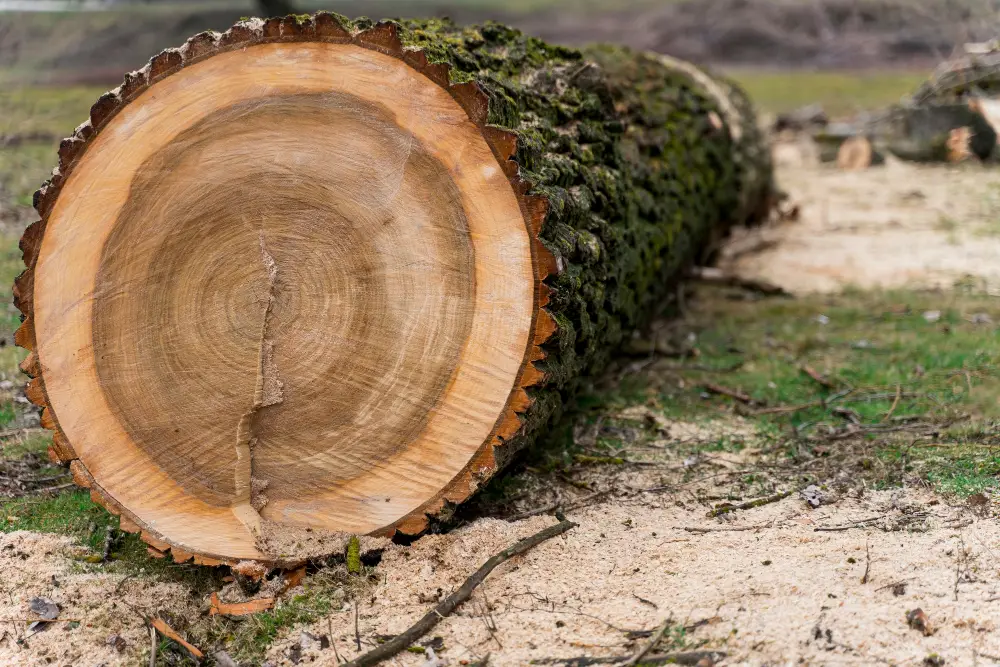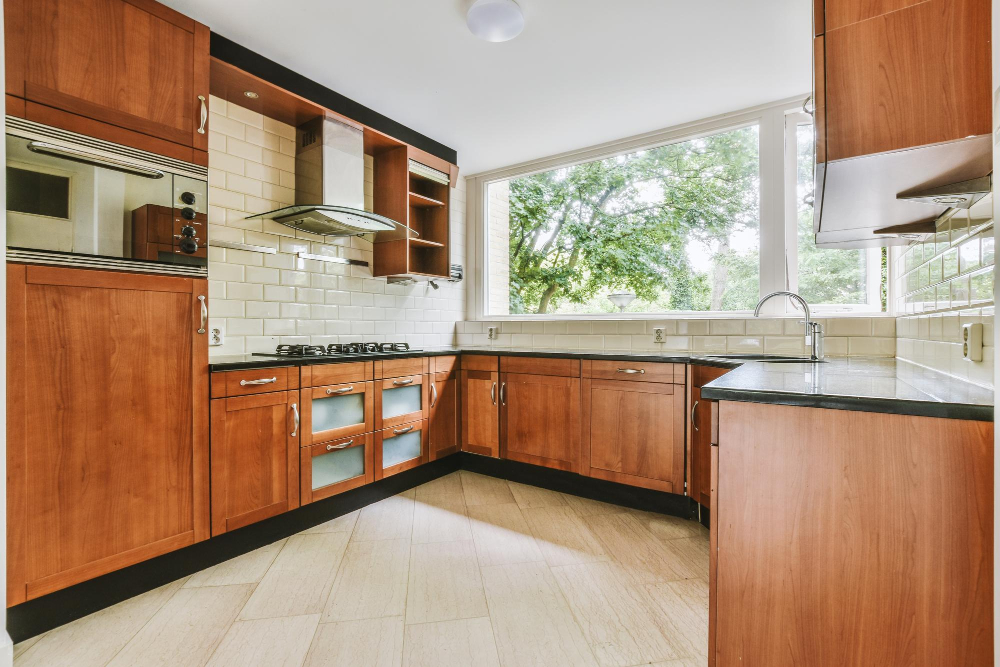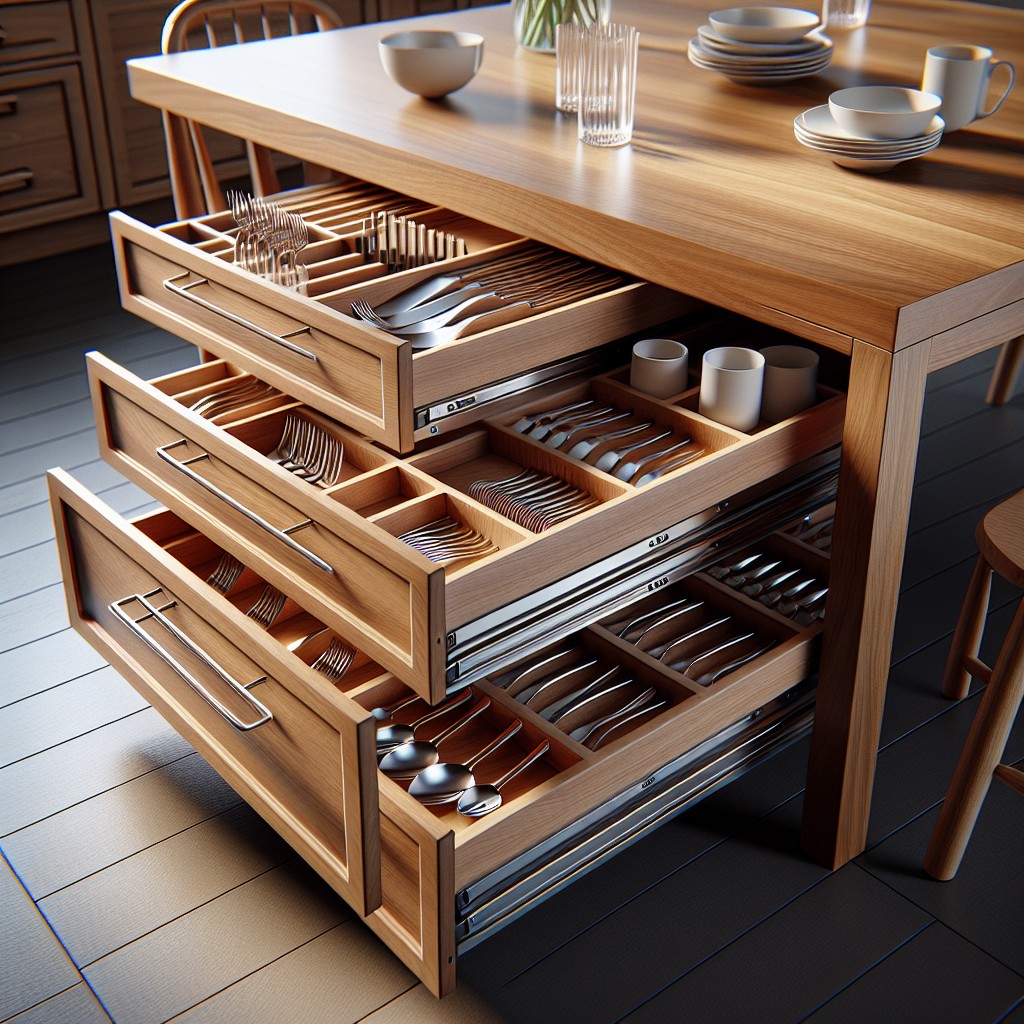Last updated on
Explore the allure of lacquered kitchen cabinets because their unique blend of style, durability, and ease of maintenance could be your next perfect kitchen upgrade.
Key takeaways:
- Lacquered cabinets offer a sleek, glossy look for your kitchen.
- They are durable and resistant to scratching, moisture, and stains.
- The smooth surface is easy to clean and maintain.
- Lacquered cabinets come in a wide range of colors for customization.
- They can enhance the visual appeal and overall value of your kitchen.
What's Inside
What Are Lacquered Kitchen Cabinets?
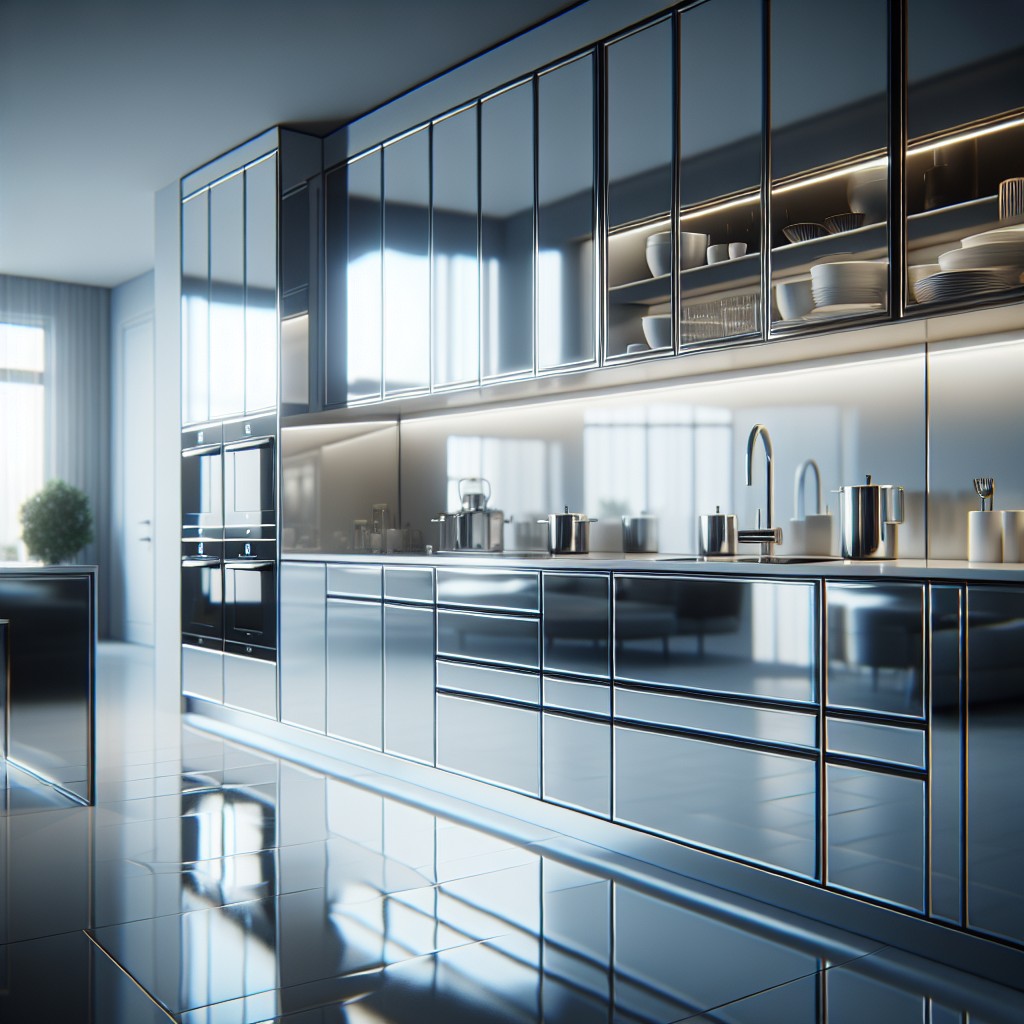
Lacquered cabinets bring a sheen and smoothness to the kitchen that are the result of their multi-layered finish. To create this effect, the wood, MDF, or plywood cabinets are coated with lacquer, a liquid mixture that contains a resin that hardens to a tough, durable film when exposed to air. The process often involves applying several coats, with sanding in between, to achieve the high-gloss or matte finish that makes these cabinets stand out.
The finish not only imparts a rich, glossy aesthetic but also provides the surface with added protection against scratching, moisture, and stains. Modern advances in lacquer formulations ensure that these finishes are less prone to yellowing and more environmentally friendly than their predecessors. As a result, they can be an excellent option for those seeking a sleek, contemporary look that doesn’t compromise on resilience.
Lacquered Cabinets: Materials and Construction
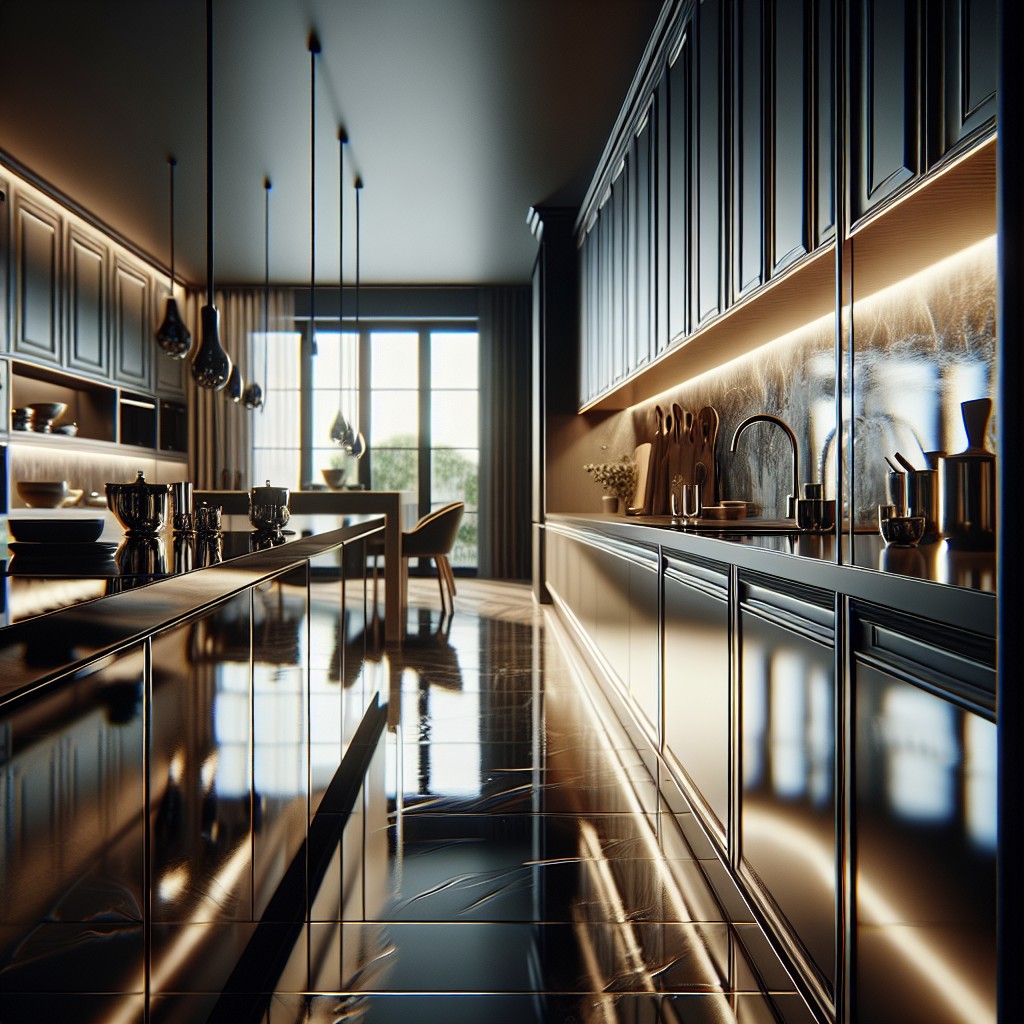
At the core of every lacquered cabinet is a foundation commonly built from high-quality materials such as MDF (Medium Density Fiberboard), plywood, or hardwood. The chosen base material influences the cabinet’s durability and final appearance.
On top of this substrate, a lacquer finish, essentially a durable varnish, is applied. The application process typically involves multiple coats, each sanded down before the next is added, resulting in a smooth, glossy surface. The luster and sheen of the final product are due to this careful layering.
Advanced techniques often involve spraying the lacquer for an even coat. This method also contributes to a seamless, mirror-like finish that is both luxurious and protective. Once cured, the lacquer forms a hard shell, creating a surface resilient to the trials of kitchen activity.
Opting for eco-friendly options, some manufacturers use low-VOC (Volatile Organic Compounds) or water-based lacquers, which are kinder to the environment and reduce harmful emissions.
Understanding these construction elements is crucial in appreciating the craftsmanship behind lacquered kitchen cabinets—and in making an informed choice about the cabinetry that suits your space and lifestyle.
Benefits of Choosing Lacquered Cabinets for Your Kitchen
Lacquered cabinets shine in more ways than one, their high-gloss finish delivering both practicality and sleek design to your culinary space.
- Visual Appeal: They offer a mirror-like sheen, instantly elevating the kitchen’s aesthetic to one that is modern and chic. This reflective quality can also make small kitchens appear larger and brighter.
- Color Consistency: The lacquering process results in an even, consistent coat. This means no blotches or uneven tones, just smooth, uniform color for a sophisticated look.
- Durability: These cabinets are known for their tough exterior, the lacquer creating a hard, protective shell that is more resistant to scratches and chips than other finishes.
- Moisture Resistance: Kitchens encounter a lot of humidity; lacquered surfaces fend off moisture, preventing warping and keeping the wood beneath in pristine condition.
- Easy to Clean: The smooth surface is simple to wipe down, reducing cleaning time and effort. Spills and splatters don’t stand a chance, making it an ideal choice for those quick kitchen clean-ups.
- Customizable: Beyond the classic black or white, lacquered cabinets can be customized in a vast array of colors, allowing for personal touches that reflect your style and complement your home’s decor.
Remember, your kitchen cabinets are not just for storage. They play a pivotal role in defining the room’s personality and functionality. Lacquered cabinets are an investment in both durability and style, offering a benefit-packed solution for anyone looking to create a statement kitchen.
Potential Drawbacks of Lacquered Kitchen Cabinets
While the allure of a glossy finish is strong, lacquered cabinets are not without their disadvantages. A significant concern is their susceptibility to scratches and chips, which can be especially noticeable on darker surfaces. This means extra care is needed to maintain that flawless appearance.
Another point to consider is the refinishing process. Over time, you may desire a fresh look or need to repair wear and tear. Unlike other finishes, lacquer requires professional refinishing, which can be more costly and time-consuming.
Also, those with a keen eye for detail may find lacquer’s perfectionism to be a double-edged sword. Any imperfection in the underlying material or application can be amplified by the smooth, reflective surface, making prep work crucial.
Lastly, environmental factors come into play; lacquered cabinets can be sensitive to extreme temperatures and humidity levels, potentially leading to cracking or discoloration over time, requiring a stable climate-controlled environment to retain their beauty.
Maintenance and Care for Lacquered Kitchen Cabinetry
Retaining the shine and finish of your cabinets need not be a chore. Gentle cleaning with a soft, damp cloth usually does the trick. Avoid abrasive cleaners or scouring pads, which can damage the smooth glossy surface. For stubborn spots, a mild, diluted soap solution can be applied, but always rinse with water and dry immediately to prevent water damage.
Regular dusting prevents particle buildup that can scratch the surface over time. Keep cabinet exteriors free of grease and cooking residue by wiping them after heavy kitchen use. Although lacquer is reasonably durable, shield it from prolonged exposure to direct sunlight, as UV rays can lead to discoloration.
Tighten hardware periodically, as loose handles can cause undue stress on the cabinet’s finish when opened or closed. For creaky hinges or drawer slides, a light application of lubricant will ensure they operate smoothly without leaving residue on the lacquered surface.
For deeper cleans, it’s recommended to use products specifically designated for lacquered furniture, to preserve the cabinet’s sheen and color vibrancy.
By establishing a consistent, gentle care routine, you can maintain the pristine condition and beauty of your cabinets for years to come.
Popular Lacquered Cabinet Colors and Trends
Neutral hues maintain a steady popularity, with whites and off-whites leading the pack for their timeless appeal. They effortlessly open up spaces, reflect light, and provide a clean backdrop for accent features.
Grays in various shades, from soft dove to deep charcoal, offer a sophisticated palette that pairs well with various decor styles, catering to modern minimalism or traditional warmth.
Black, making a bold statement, brings an air of luxury and depth to the kitchen. Its rise reflects a growing preference for sleek, dramatic designs that challenge the conventional light kitchen paradigm.
Navy and deep blues are trends to watch as they infuse a sense of calm sophistication and can be matched creatively with metallic hardware for a chic look.
Pastels, though less common, are emerging as a whimsical and personality-rich option. Light pinks, soft greens, and pale blues provide a subtle pop of color, personalizing spaces without overwhelming them.
Whichever color trend catches the eye, the high-gloss finish of lacquer ensures a vivid expression of color, enhancing the visual impact and creating dynamic reflections that change with the lighting through the day.
Upgrading Your Kitchen: The Impact of Lacquer On Aesthetics and Value
Upgrading your kitchen with lacquered cabinets can significantly enhance the room’s visual appeal, adding a glossy, sophisticated finish that reflects light and makes the space appear brighter and larger. The smooth and customizable surface of lacquer allows for a range of colors, from vibrant hues to timeless neutrals, letting homeowners match their cabinetry to their personal style and the latest design trends.
Investing in lacquer also contributes to the overall home value. Kitchens are a focal point for potential buyers, and the luxe look of lacquered cabinets often translates to a higher perceived value of the property. It gives the impression of a well-maintained and modern space, which can be a deciding factor during property valuation.
Moreover, the hard-wearing nature of lacquer means that this upgrade is not only aesthetic but also practical. The durability of the finish, when properly cared for, ensures the cabinets remain a highlight in the kitchen for years to come, protecting your investment in both the short and long term.
Lacquer Kitchen Cabinet Design Ideas and Inspiration
Dive into design possibilities and infuse your kitchen with personality by exploring various lacquer finishes and styles.
- High-Gloss Brilliance: Opt for high-gloss lacquered cabinets to deliver a reflective sheen that enlarges the feel of the space and brings modern sophistication.
- Matte for Elegance: Choose matte finish cabinets for a contemporary look that minimizes fingerprints and glare while exuding understated luxury.
- Bold Color Statements: Go beyond the classic whites and creams with lacquered cabinets in deep navy, vibrant green, or even sunflower yellow for a cheerful and unique kitchen.
- Two-Tone Kitchens: Mix and match shades, pairing lighter upper cabinets with darker lower counterparts for a grounding yet dynamic design effect.
- Textural Contrast: Combine lacquered cabinets with natural materials like wood or stone for a tactile contrast that adds depth and interest to your kitchen.
- Hardware Highlights: Select statement hardware to complement your lacquered cabinets, turning them into a cohesive component of the kitchen’s overall aesthetic.
Experiment with these ideas to create a space that’s visually arresting and tailored to your home’s character and your personal style.
Lacquer Vs Paint: Comparing Kitchen Cabinet Finishes
When deciding between lacquer and paint for your kitchen cabinets, the key lies in understanding their distinct attributes:
- Application: Lacquer is typically sprayed on, creating a smooth, consistent finish that is hard to achieve with a brush or roller for paint. This often results in a more professional appearance.
- Drying Time: Lacquer dries significantly faster than paint, reducing the time your kitchen is out of commission.
- Durability: While both finishes offer protection, lacquer tends to be more resistant to damage. It’s known for its hard, yet slightly flexible coat, which can be less prone to cracking.
- Sheen: Lacquer generally provides a glossier finish than paint, which can be desirable for a more modern or polished look.
- Ease of Repair: Touching up a lacquered surface is often easier than paint; it can be seamlessly repaired with additional lacquer, blending the old and new finish.
- Color Fidelity: Paint may change color over time, especially under UV light, whereas lacquer maintains its color better.
- Toxicity: Lacquer can be more toxic and requires a well-ventilated space when applying due to its high volatile organic compound (VOC) levels.
Selecting between the two finishes will depend on your specific needs and priorities such as durability, drying time, appearance, and ease of maintenance.
Cost Considerations for Lacquered Kitchen Cabinets
Understanding the financial aspect of lacquered kitchen cabinets is crucial when planning your remodel. Lacquering, a labor-intensive process that often involves multiple coats and meticulous sanding, typically comes with a higher price tag compared to other finishes.
Material Quality: The type of lacquer and the quality of underlying materials influence cost. Premium lacquers that are more durable will be more expensive.
Cabinet Construction: Ready-to-assemble (RTA) cabinets with lacquer finish are usually less costly than custom or semi-custom options. The complexity of the cabinet design also plays a role in the overall cost.
Labor Intensity: Lacquering requires professional application. The craftsmanship level, the number of layers, and the degree of gloss or matte finish determine the labor costs.
Scale of Project: The size of your kitchen and the number of cabinets to be lacquered directly affect the price. Larger kitchens with more cabinetry will require more material and labor.
Refinishing vs. New: Opting to refinish existing cabinets with lacquer, rather than purchasing new ones, can be a cost-saving avenue, albeit it still requires professional skills for best results.
Geographical Variation: Installation costs can vary significantly depending on regional labor rates. Obtaining multiple quotes can help in getting the best deal.
Maintenance Over Time: Consider the long-term upkeep costs. Lacquered surfaces may require professional touch-ups to address wear and tear, contributing to overall expense.
Knowing these factors helps you create a budget that aligns with your vision for a beautifully lacquered kitchen without unwelcome financial surprises.
The Durability and Longevity of Lacquered Kitchen Cabinets
Lacquer finishes are renowned for their hard and durable surface which can withstand the demands of a busy kitchen. When properly cared for, this type of cabinetry can resist scratches, stains, and fading, preserving its glossy and elegant appearance over time.
The lifespan of a lacquered finish often exceeds that of ordinary painted surfaces, assuming appropriate maintenance is observed. Here are a few key points about the enduring nature of lacquered cabinets:
- Heat Resistance: Lacquer has the ability to withstand heat better than many other finishes, making it a suitable choice for the kitchen where heat exposure is common.
- Moisture Resistance: The sealed and smooth surface of lacquer repels water and moisture, preventing damage that can be caused by steam and spills.
- Ease of Repair: Although durable, if a lacquered cabinet does get chipped or scratched, it can be more easily repaired and refinished than other surfaces, restoring it to its original state.
- Consistent Look: Unlike some finishes that discolor or dull over time, a quality lacquered surface maintains its depth of color and shine, helping your kitchen to look pristine for years.
Understanding that the longevity of lacquered cabinets hinges on the quality of the initial application and regular maintenance underscores their suitability for households looking for a long-lasting kitchen solution.
Lacquer Cabinets in Modern Kitchen Design
Integrating lacquer cabinets into modern kitchen design can elevate the space with a sleek and luxurious finish that complements contemporary aesthetics. Here are key considerations for incorporating lacquer finishes in modern kitchens:
- High Gloss Appeal: The reflective sheen of lacquer pairs perfectly with the clean lines and minimalist themes prevalent in modern design, offering a polished look that captures and reflects light beautifully.
- Color Pop: Lacquer’s versatile application allows for bold color choices, adding a dynamic visual element to a modern kitchen. From vibrant reds to deep blues, lacquer can act as an accent or focal point.
- Mix and Match: Combine lacquer with other materials like wood, metal, or glass to create a mix of textures and finishes, avoiding a monolithic look and adding character to your kitchen.
- Handleless Cabinets: For an uncluttered appearance, lacquered cabinets work well in handleless designs, utilizing push-to-open mechanisms that enhance the modern feel.
- Lighting Effects: Consider the impact of both natural and artificial lighting on lacquered surfaces which can dramatically change the ambiance and mood of the kitchen throughout the day.
By keeping these aspects in mind, lacquer cabinets can be seamlessly integrated into the modern kitchen, providing both functionality and a high-end aesthetic.
Gallery: Showcasing Lacquered Cabinets in Various Styles
Dive into a visual feast where glossy finishes meet diverse design motifs, offering endless inspiration for your own kitchen remodel.
Sleek Minimalism: Embrace the seamless look of white high-gloss cabinets paired with a monochrome palette and metallic accents. Notice how light bounces off the surfaces, enhancing the sense of space.
Bold Contrasts: Observe cabinets in deep blues or greens set against marble countertops or backsplashes, creating a statement of luxury and depth.
Retro Vibes: Check out how softer, pastel-hued lacquer cabinets can transport you to a mid-century modern era, especially when matched with vintage hardware and wood grain elements.
Warm Neutrals: Pay attention to the subtle elegance of creamy or taupe lacquered cabinets that can soften your kitchen’s look while maintaining a contemporary edge.
Each image in the gallery is carefully selected to show lacquered cabinets’ versatility in different kitchen layouts, sizes, and lighting conditions. Notice the details that make each setup unique, such as the choice of handles, the kitchen island design, and the harmony between the cabinets and flooring. Use these visual cues to guide your design process.
FAQ
Is lacquer good for kitchen cabinets?
Lacquer, being one of the highest-quality paint finishes on the market today, is an excellent choice for kitchen cabinets, despite requiring application in a controlled environment.
Are lacquer kitchen cabinets expensive?
While the cost of lacquer kitchen cabinets can vary based on material, size, and type of lacquer used, typically, cabinets made from hardwoods are more expensive as compared to those made from MDF, particleboards, or melamine.
Are lacquered kitchens any good?
Yes, lacquered kitchens are highly valued due to their reflective surface that resists moisture and stains, along with a variety of finishes and colors that offer limitless design possibilities.
What is the most durable finish for kitchen cabinets?
The most durable finish for kitchen cabinets is the melamine finish, created by heat-sealing thermally fused melamine resin to a hardwood substrate like pressed wood, medium-density fiberboard, or plywood.
What is the process of applying lacquer to kitchen cabinets?
The process of applying lacquer to kitchen cabinets typically involves cleaning the cabinets, removing any old finish, sanding the wood, applying a sealer, and then applying several coats of the lacquer with ample drying time between each coat.
How does the upkeep and maintenance of lacquered kitchen cabinets compare to other finishes?
Lacquered kitchen cabinets require more meticulous care and maintenance compared to other finishes due to their high-gloss finish that shows fingerprints and scratches more prominently.
What variety of color options are available for lacquered kitchen cabinets?
Lacquered kitchen cabinets are available in a wide variety of colors, including but not limited to white, black, red, blue, green, orange, and even customized shades to match your specific interior design style.
Continue reading:
